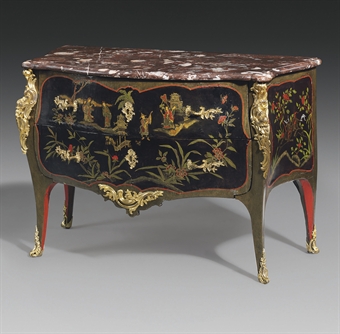The new style took its name from the French word for rockwork - 'rocaille' (rococo in Italian). Its features included flowers, arabesques, C and S shaped scrolls, cupids, Chinese figures, and scallop shells. Pineau, a Parisian wood carver and interior designer was Meissonier's contemporary. Their engravings influenced all the decorative arts and were copied in other publications and by other craftsmen, spreading the Rococo style far and wide.
George 1 Chest-On-Chest
Very fine quality George I walnut chest on chest, circa 1715-1725, of wonderful colour and proportions with gilt bronze mounted columns to the sides.

The New Styles
Rococo furniture was interpreted in many different ways throughout Europe and America, but they all had certain features in common. Pieces of furniture were smaller, lighter, and more curvaceous in form than earlier styles, often with curved cabriole legs and pad or claw-and-ball feet.
Women, such as Louis XV's mistress, Madame de Pompadour, were very influential and coveted small, decorative pieces that were suitable for intimate salons and appealed to the 18th century taste for informality and leisure.
Many new types of chair appeared, reflecting the demand for greater comfort and the interest in conversation. The high-backed chair, typical of Louis XIV's reign, gave way to chairs with a lower, slightly shaped back, a lighter frame, and visible wooden framework, including arched crest rails.
Upholstered furniture, now reproduction furniture, was more widely available than before. Stretchers disappeared or were reduced to two cross pieces in X-formation with restrained moulding, although they were still occasionally used in Scandinavian and Spanish furniture.
Decorative Influences
Decoration was derived from Classical architectural motifs, Oriental patterns, and, in England, from Gothic designs. Oriental screens and lacquerwork were popular throughout the period. In colonial ports, japanning continued into the 1740's, while in France and England, lacquer panels were cut out of 17th century non fitted furniture and incorporated into mid 18th century pieces.
Motifs depicting Chinese figures and willow trees appeared in all the decorative arts, but particularly in mid-century mirror frames, when the Rococo style was at its peak.
The duchesse brisee
This has sumptuously upholstered cushions and a stool to support the legs. A new desire for comfort made the upholstered chair more popular.
The Commode
Commodes first appeared at the beginning of the century at the court of Louis XIV. The form was quickly adopted by other countries and adapted to their particular needs. The term itself comes from the French word for greater convenience, 'commodite'. The two drawer commode on tall legs was the first version, but by the Regence it usually had three or more drawers on short feet (commode a' la Regence).
During Louis XV's reign, the two drawer chest on two curved legs with curved sides was favoured. The facade was treated as a single decorative unit and the division between the drawers was ignored.
Commodes were frequently made with a matching pair of corner cupboards known as encoignures. Pieces with a vertical curve were known as 'bombe', while horizontal curves were called 'serpentine'.

No comments:
Post a Comment